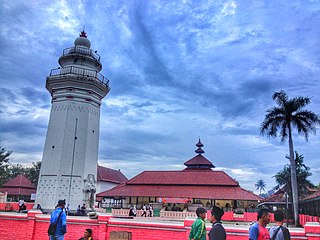
Demak Great Mosque is one of the oldest mosques in Indonesia, located in the center town of Demak, Central Java, Indonesia. The mosque is believed to have been built by the Wali Songo with the most prominent figure, Sunan Kalijaga, during the first Demak Sultanate ruler, Raden Patah, during the 15th century.

Sultanate of Banjar or Sultanate of Banjarmasin was a sultanate located in what is today the South Kalimantan province of Indonesia. For most of its history, its capital was at Banjarmasin.

Tanjungpura Kingdom or Tanjompura was the name of an ancient 8th century kingdom that was located along the southwestern coast of Borneo facing the Java Sea, a region that today corresponds to the Ketapang Regency of West Kalimantan province of Indonesia. The kingdom experienced several moves of the royal capital, first located in Negeri Baru Ketapang Regency, then moved to Sukadana, since Panembahan Sorgi embraced Islam.

Angke Mosque, officially known as Masjid Jami Angke or Masjid Al-Anwar, located at Tambora, Jakarta, Indonesia. It is one of the oldest mosques in Jakarta. Well-maintained and retaining its original form, the mosque has been called by the historian Denys Lombard as 'une des plus élégantes de la vieille villa'. The history of the mosque reflects the multiethnic and multilayered origin of colonial Jakarta.

The Great Mosque of Surakarta is an 18th-century Javanese mosque in Surakarta, Central Java, Indonesia. It is the royal mosque of the Surakarta Sunanate.

The Great Mosque of Sumenep is an 18th-century mosque in Sumenep, Madura. Standing on the alun-alun of Sumenep, it is the largest mosque on Madura Island and a noted landmark of Madura.

The Great Mosque of Palembang, also known as Sultan Mahmud Badaruddin I Great Mosque after the former Sultan of Palembang, is the main mosque of Palembang, the capital of South Sumatra. The mosque is the largest in South Sumatra, and the third largest mosque in Sumatra after the Grand Mosque of West Sumatra and Great Mosque of Pekanbaru.

Kasunyatan Mosque is a small mosque in the village of Kasunyatan, Banten, Indonesia. Established between 1570 and 1596, it is one of the oldest mosques in Indonesia. The mosque is located in close proximity to the ruins of Old Banten, and functioned as a 16th-century centre of Islamic study. The mosque received a heritage status during the Dutch colonial period in 1932.

Great Mosque of Banten is a historic mosque in Old Banten, 10 km north of Serang, Indonesia. The 16th-century mosque was one of the few surviving remnants of what used to be the port city of Banten, the most prosperous trading center in the Indonesian archipelago after the fall of Demak Sultanate in mid-16th century.

Azizi Mosque is a mosque located in Tanjung Pura, Langkat Regency, North Sumatra, Indonesia. It was the royal mosque of the Sultanate of Langkat.

The Jami Syekh Abdul Hamid Abulung Mosque, also known as Datu Abulung Mosque, is an old mosque in South Kalimantan province, Indonesia, which is located in Sungai Batang village, West Martapura district, Martapura. The mosque was built by the king of Banjar, Sultan Tahmidullah II who ruled the area during 1761 to 1801, as a form of retribution for ordering the executions of Datu Abulung, a scholar who had been accused of heresy. The mosque is one of the cultural heritages in Martapura.

Jami Mosque of Taluak is one of the oldest mosques in Indonesia, located in Taluak IV Suku Nagari, Banuhampu District, Agam Regency, West Sumatra. The location of the mosque is close to the border of Bukittinggi, thus it is also known as Jamik Taluak Mosque Bukittinggi.
The Al-Mansur Mosque is one of the oldest mosques in Jakarta, Indonesia.The mosque is located at Jembatan Lima, Tambora, Jakarta. The mosque is one of the listed cultural heritage of Jakarta. The mosque is named after Kh. Mohammad Mansur who is familiarly called Guru Mansur- a Betawi figure known for his fight against Dutch colonial rules.

Kyai Gede Mosque, officially known as the Jami Mosque of Kotawaringin, is a mosque located in West Kotawaringin Regency, Central Kalimantan, Indonesia.

Mosque architecture in Indonesia refers to the architectural traditions of mosques built in the archipelago of Indonesia. Initial forms of the mosque, for example, were predominantly built in the vernacular Indonesian architectural style mixed with Hindu, Buddhist or Chinese architectural elements, and notably didn't equip orthodox form of Islamic architectural elements such as dome and minaret. Vernacular architectural style varies depending on the island and region.

Jami Mosque of Pontianak, also known as Sultan Syarif Abdurrahman Mosque, is the oldest mosque of Pontianak, in Kalimantan, Indonesia. The large wooden mosque, together with the royal palace of Kraton Kadriyah, was among the first buildings constructed in the city following the establishment of Pontianak in 1771.

The Mempawah Kingdom also known as the Mempawah Sultanate, was an Islamic Dayak kingdom located in a territory now known as the Mempawah Regency, West Kalimantan, Indonesia. The name Mempawah is taken from the term "Mempauh", which is the name of a tree that grows in the upper reaches of the river, also known as the Mempawah River. In its development, Mempawah became known as the name of one of the kingdoms and sultanates that developed in West Borneo. The history of Mempawah is divided into two periods, namely the Dayak kingdom based on Hindu teachings and the period of Islamic influence.


























